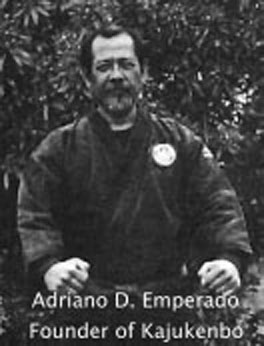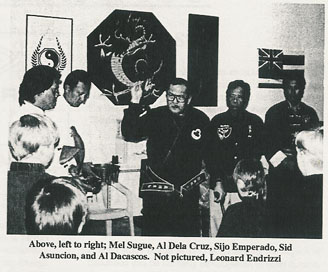|
|
|
Kaju what?
The art of Kajukenbo was developed in the Palama settlement of Hawaii, on the island of Oahu. In 1947 five men all masters in their respective arts realized that their arts were not 100 percent suitable for street self defense. They made a pact to create an art that would be suitable for street self defense. The men trained in secret for two years refining their skills and became knowing as the Black Belt Society. The training was known to be extremely brutal and the techniques they developed were tested on the streets prior to adding them to the art. These five men were Adriano Emperado, Frank Ordonez, Peter Y.Y. Choo, Joe Holke, and Clarence Chang.
KAJUKENBO is actually an acronym for the five styles that it was founded from. These arts were:
KA- comes from the word karate, Peter Y.Y. Choo brought the Korean Karate art of Tang Soo Doo to the system. This is where our kicking comes from.
JU- comes from Judo and Jujitsu, Joe Holke brought Kodenkan Danzan Ryu, and Se Kieno Ryu was brought by Frank Ordonez. This is where we get our throwing, joint locking, sweeps, chockes and ground grappling from.
KEN- comes from Kenpo, Adriano Emperado brought Kosho Shorei Ryu to the system. This is where we the hard and fast multiple hand striking from.
BO- comes from Chinese and American Boxing that Clarence Chang brought to the system. This is where we get our evasive and perrying techniques
|
 Sijo
Sijo
HOW IT WORKS
Kajukenbo was designed to be a full circle martial art. This means unlike most arts that fight in one or two fighting ranges, Kajukenbo defends against attacks from all four ranges: kicking,boxing,trapping,and grappling. In addition Kajukenbo also teaches defenses against knife, gun, and club attacks. Kajukenbo basic pholosophy is to block and counter with a series of blows. Instead of teaching a one strike onekill theory, Kajukenbo teaches students to follow through with their defense until the threat is neutralized. |
|
Black Belt Magazine Article
Adriano Emperado
1991 Instructor of the Year by William Beaver
(for Black Belt Magazine Hall of Fame Issue - 1991) Five martial artists calling themselves the Black Belt Society met in a tough, seedy area of Honolulu known as the Palama Settlement in 1947. They were there for only one purpose: to develop the ultimate self-defense system.
Peter Y.Y. Choo brought his expertise in the Korean art tang soo do. Frank Ordonez contributed years of experience in se keino jujitsu. Joseph Holek shared his mastery of kodekan judo. Clarence Chang was a teacher of shaolin kung fu. And the fifth member of the Black Belt Society, a master of Chinese kara-ho kempo and Filipino escrima, was Adriano Emperado.
After two years of exchanging ideas and techniques, these five martial masters created a streetwise, highly effective combat system which derived its name from the first letters of the four styles it was comprised of. Since then, this now familiar style known as Kajukenbo has developed a reputation as "the perfected art of dirty streetfighting," as one member called it.
Emperado, who opened the first kajukenbo school in the United States, had a rugged childhood on the rough-and-tumble back streets of Honolulu. His initial martial arts training was in escrima, which later influenced aspects of his kajukenbo. Emperado later took up kempo and reached the rank of fifth-degree black belt while studying under William K. S. Chow.
The first kajukenbo school was opened in the Palama Settlement, and operated by Emperado and his brother, Joe. The brutal training that took place there is legendary. Since the goal was to be invincible on the street, the training had to be realistic, and students sparred with full contact. Broken bones were an everyday occurrence, and the trauma of training caused others to become sick to their stomachs. The number of students at the school soon dwindled to a dedicated few.
Those who remained developed into tough fighters with a reputation for employing their art in streetfights with only a little provocation. Emperado's school turned out several future instructors who would themselves leave a mark on the international martial arts community: Sid Asuncion, Tony Ramos, Charles Gaylord, Aleju Reyes, Joe Halbuna and Al Dacascos, just to name a few.
In 1959, Emperado began incorporating kung fu into the kajukenbo system, shifting the emphasis away from strictly hard-style karate to a combination of hard and soft techniques. Kajukenbo has evolved into a style open to improvement and willing to accept what works.
Today, kajukenbo has four distinct branches, reflecting its wide spectrum of influence. The original base of kajukenbo (often referred to as the kempo division) has been joined by divisions within the art known as chuan-fa (fist way), a combination of hard and soft Chinese techniques; tum-pai, which adds tai chi chaun; and wun hop kuen do, which was developed by Black Belt Hall of Fame member Al Dacascos.
Modern kajukenbo, drawing on its Hawaiian heritage, is a large, extended family, but maintains its reputation as an art prepared for any street encounter. Emperado continues to travel and conduct seminars in the art which he helped develop more than 40 years ago. For a lifetime of contributions to the martial arts, Black Belt is proud to name Adriano Emperado its 1991 Instructor of the Year.
|
|
|
 This is one of my favorite images
This is one of my favorite images
This picture shows most of my lineage from Sijo Emperado, GM Sid Asuncian, and Professor Dela Cruz. Missing is Professor Chuck Stevenson. |
|
|
|


